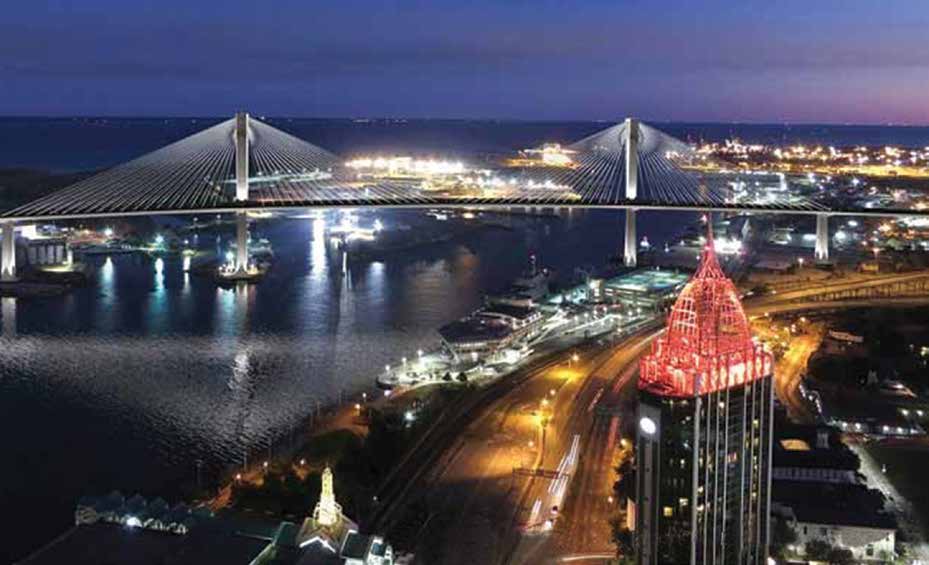About the Mobile Chamber
The Mobile Chamber is a private business organization with more than 1,700 members and the economic developer for the City of Mobile and Mobile County. The Mobile Chamber’s focus is to provide members with networking, marketing and professional development opportunities, expand jobs in the area, develop the local workforce, advocate legislative priorities and offer resources to help small businesses grow. Additional information is on the Chamber’s website, Facebook, Instagram, LinkedIn, Twitter and YouTube.
Five Things to Know About the Mobile River Bridge and Bayway Project
The Business View – July 2018 / Mobile River Bridge
The Business View recently asked the Alabama Department of Transportation (ALDOT) to give our readers an update on the Mobile River Bridge and Bayway project. While you may not see construction crews in place yet, much is happening behind the scenes to keep this project moving forward. Here are five things you need to know about the project.
First, the why:
The project area spans I-10 from Virginia Street in Mobile to the U.S. Hwy. 90/98 interchange in Spanish Fort. As locals know, summertime brings travelers. Travelers mean congestion on I-10. The Wallace Tunnel, a key part of the I-10 corridor, was built to accommodate 36,000 vehicles daily. Currently, that number exceeds 75,000. And during holiday peak season, the number surpasses 100,000. This increased traffic causes backups that extend several miles. If the project is not built, the traffic we see during peak travel times in the summer will be the daily traffic within 20 years.
The completed expansion is expected to reduce travel time from Mobile to the Eastern Shore, increasing reliability and accessibility to jobs, educational facilities, medical services and recreational activities. The project is anticipated to facilitate access to/from major industries and freight destinations in Mobile and provide hazardous material vehicles a direct route away from the downtown business district.
Second, the what:
To relieve congestion on I-10, ALDOT proposes a 12-mile widening project with three major components: a six-lane cable-stayed bridge over the Mobile River; 7.5 miles of eight lane bridges across the Mobile Bay (the Bayway); and five interchange modifications. The Mobile River Bridge’s vertical clearance of 215 feet assures continued operations of Mobile’s maritime industry. The new Bayway will sit 14 feet higher above the 100-year storm surge level. All existing interchanges will remain in place, but will be reconfigured for safe, easy access to the bridges. The new Mobile River Bridge will offer an observation deck, allowing visitors to take in sweeping views of Mobile Bay. Improvements to bicycle paths will extend over the Cochrane-Africatown Bridge.
Next, the how and who:
ALDOT estimates the project to cost approximately $2 billion, and the state agency is currently pursuing an array of possible funding vehicles, (especially in light of other needs across the state), including federal grants, loans, bonds and tolling. Through a Public Private Partnership (P3), a private developer, or concessionaire, will work with ALDOT to design, build, finance, operate and maintain the project. ALDOT will maintain ownership of the roadway throughout the duration of the 55-year partnership.
A P3 uses public and private funds to accelerate the delivery of the project. Private sector technical, innovation, management and financial resources will help achieve the project’s objectives. It provides a process for generating the funds necessary to make costly, but critical, improvements to the regional transportation system in an efficient manner. Toll collection will help repay the necessary long term debt incurred to bring the project to fruition.
This is ALDOT’s first P3 and tolling project. Toll collection will be done through All-Electronic Tolling (AET), allowing drivers to travel through the facilities without stopping to physically pay a toll. Electronic toll gantries above the roadway will collect data from a transponder or license plate. Through traffic – drivers passing through the area without stopping – will account for nearly half of all vehicles using the corridor. AET collection assures that those who use the route pay for it.
The toll rate has not been determined, but ALDOT is committed to a frequent-user discount and non-tolled routes, which will include U.S. Hwy. 90/98 (the Causeway) and Cochrane-Africatown Bridge.
Finally, the when:
The Mobile River Bridge and Bayway project is currently in an industry review period. Three concessionaire teams are working with ALDOT to further the development of the request for proposals. Concurrently, ALDOT is finalizing the environmental requirements. A public hearing will take place this fall. ALDOT expects to select the private partner by early 2019. Construction on the new bridge should begin by the end of 2019 and be open in 2025.
Stay connected to the project developments at www.mobileriverbridge.com.
Click here to read The Business View – July 2018
Additional information is on the Mobile Area Chamber of Commerce’s website at www.mobilechamber.com, on Facebook at @MobileChamber and Twitter at @MobileChamber.

